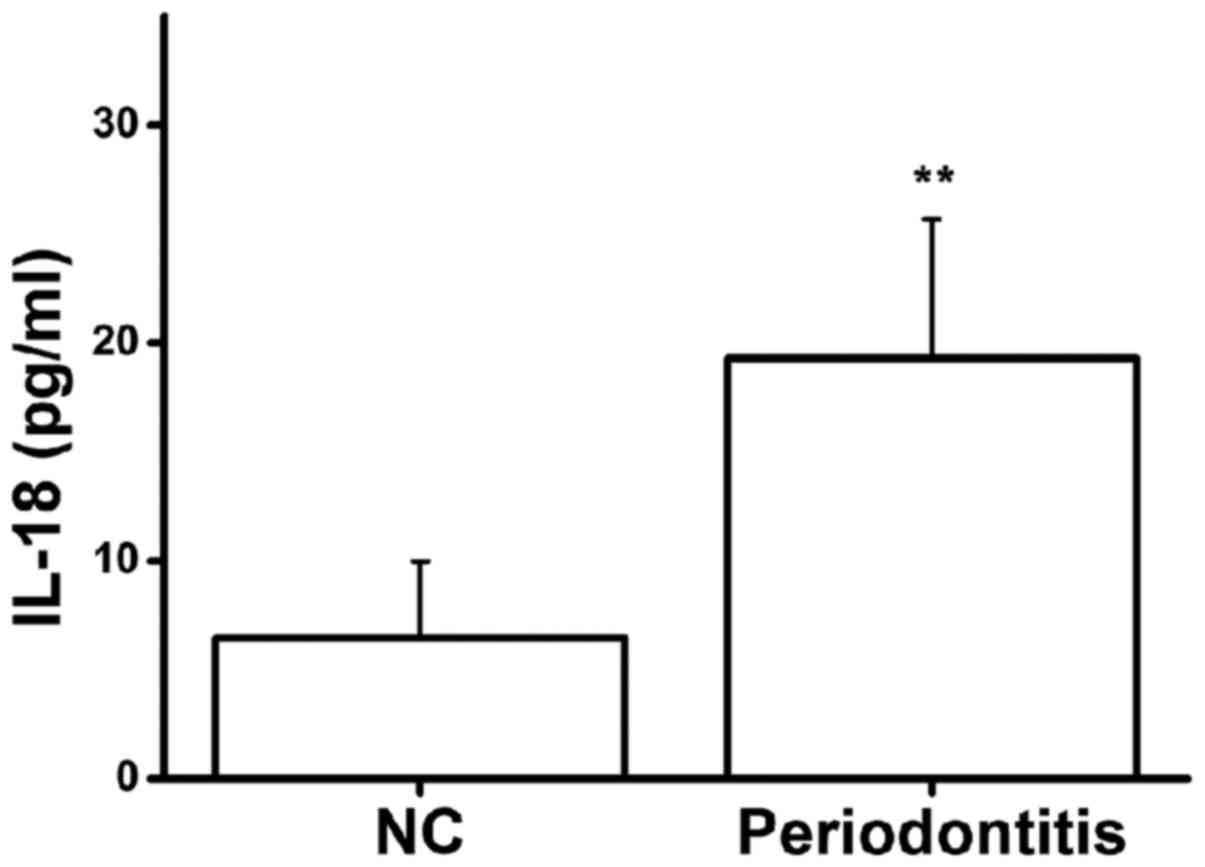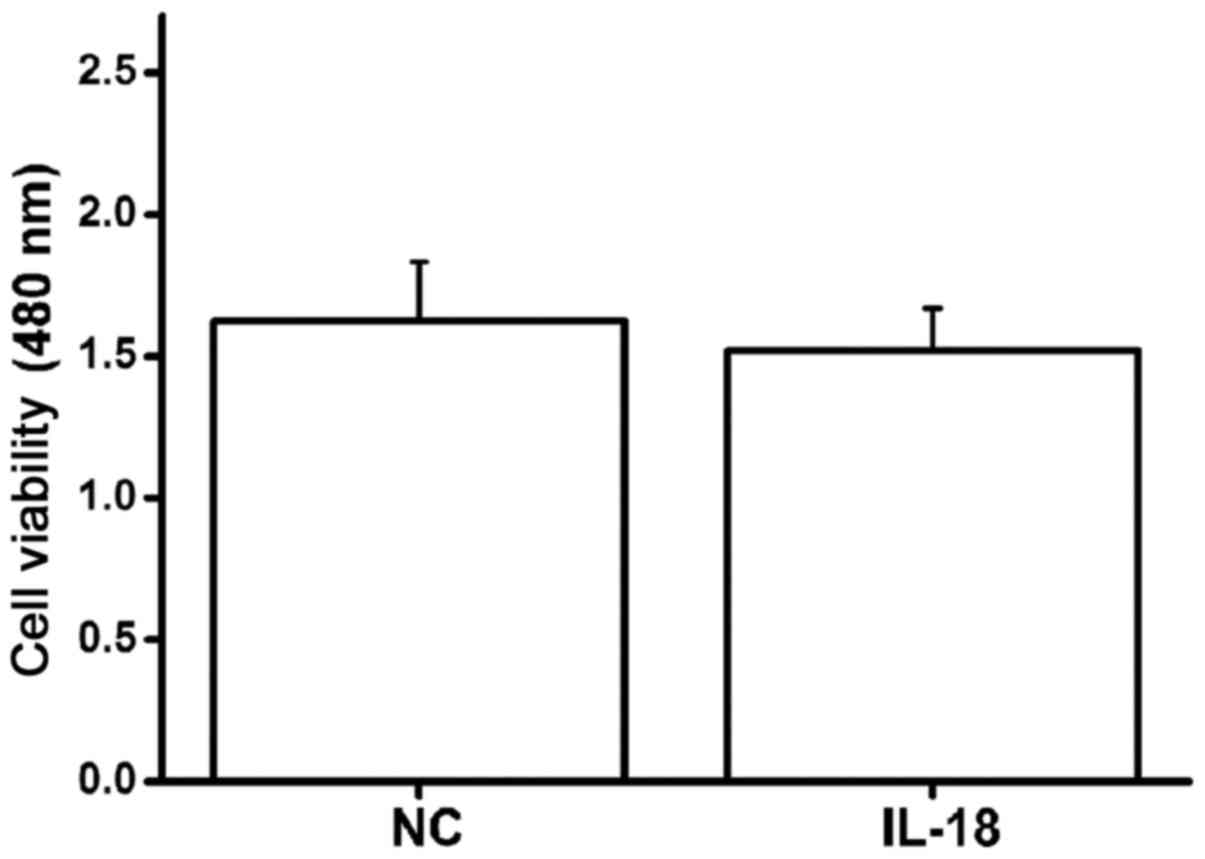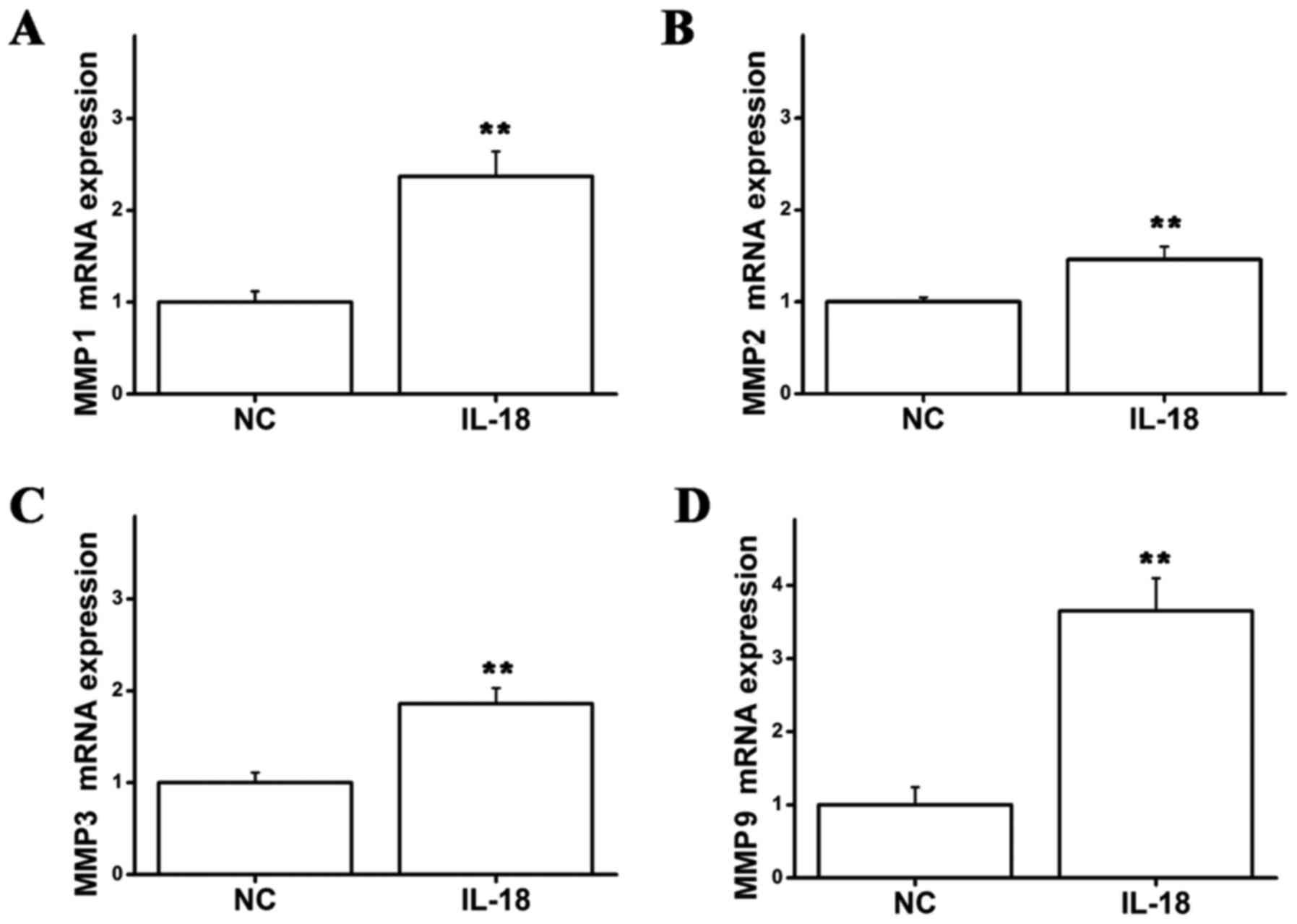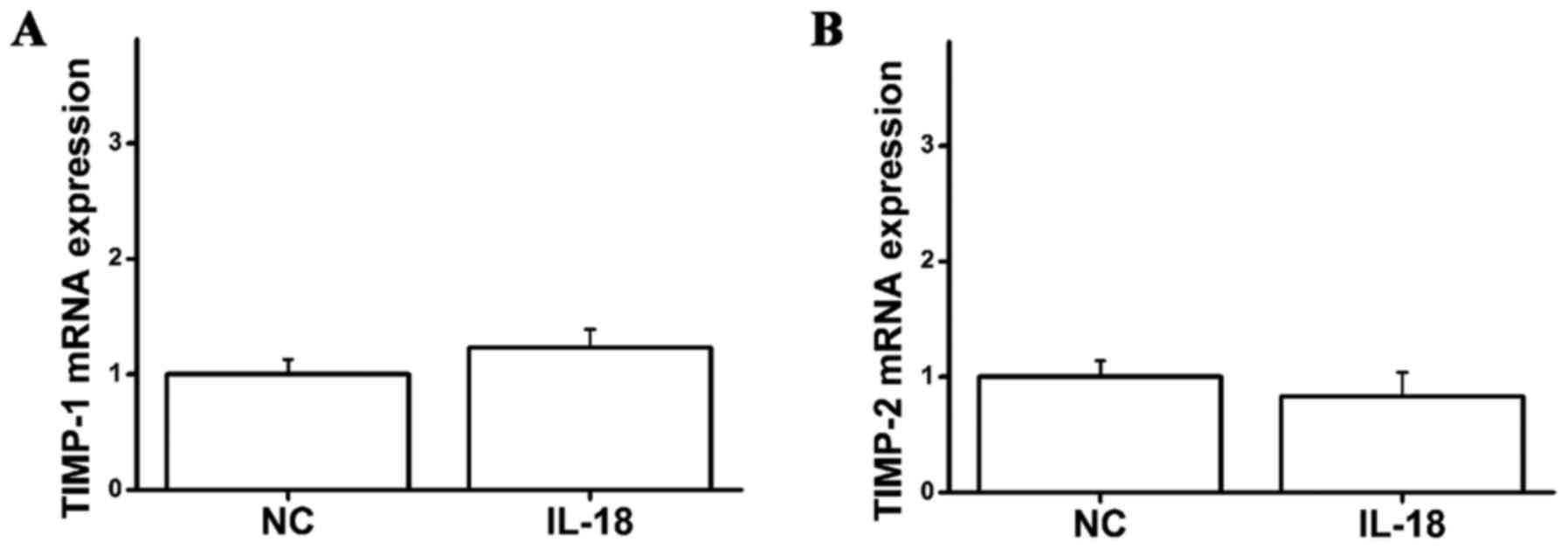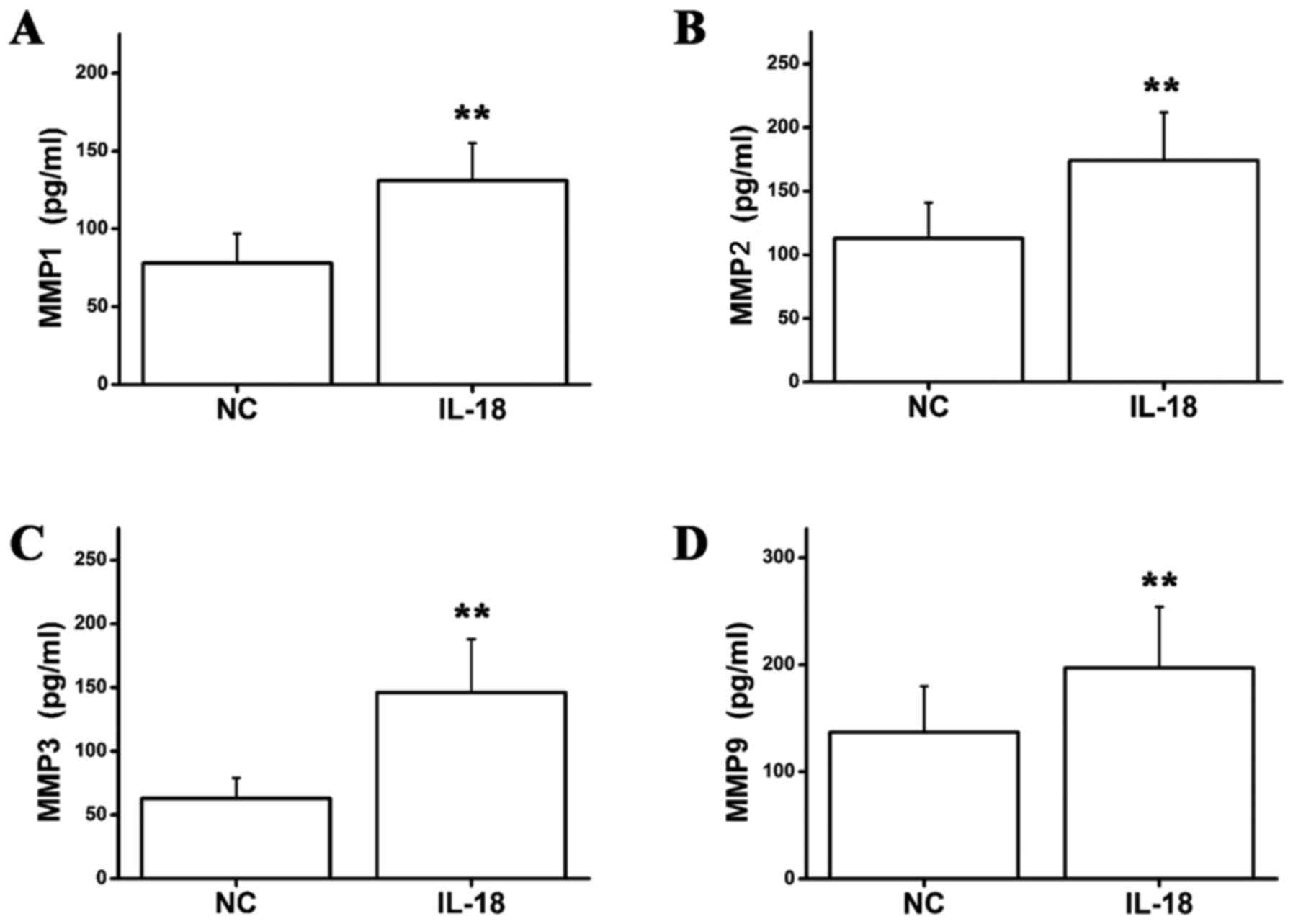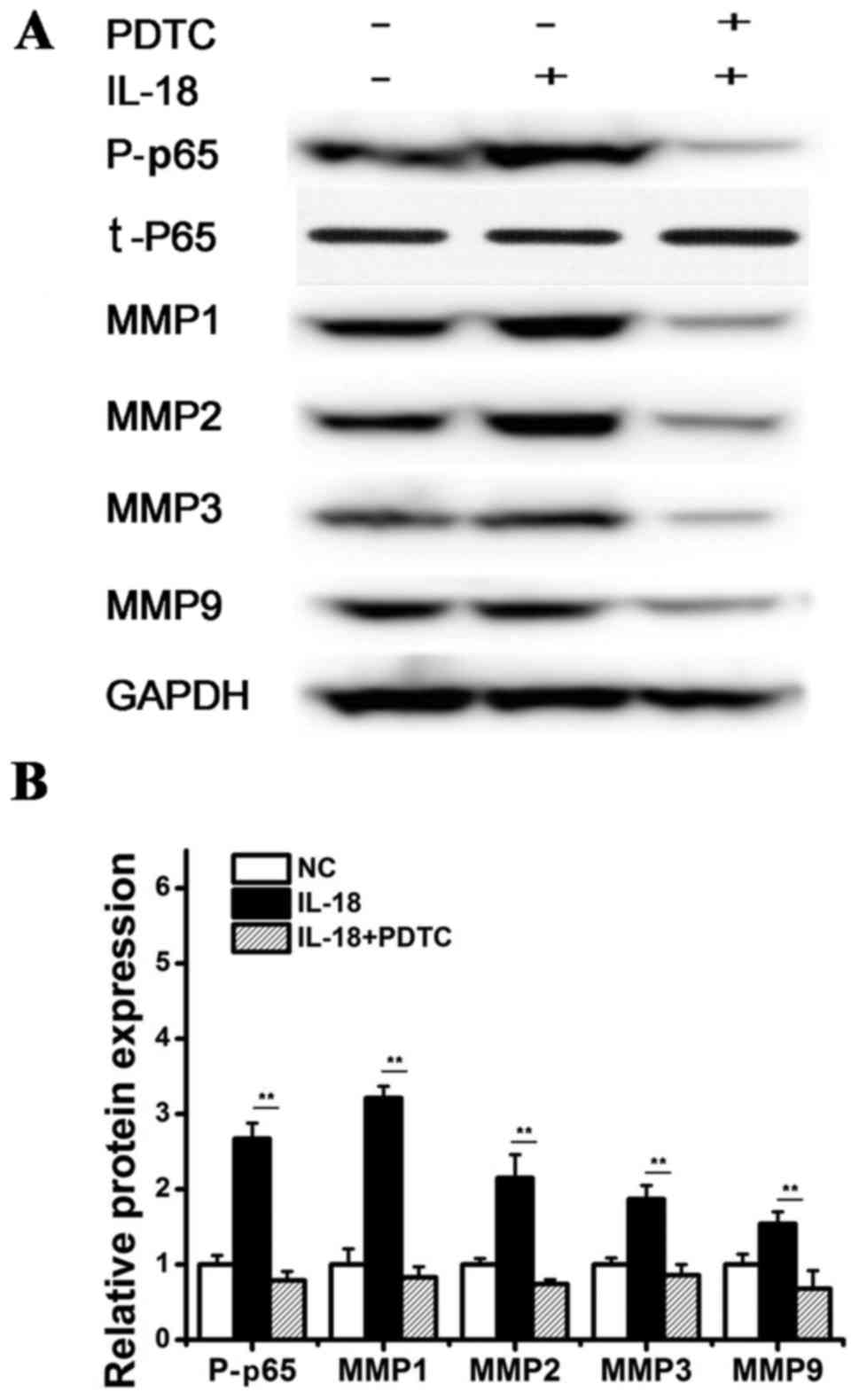IL‑18 promotes the secretion of matrix metalloproteinases in human periodontal ligament fibroblasts by activating NF‑κB signaling
- Authors:
- Published online on: November 26, 2018 https://doi.org/10.3892/mmr.2018.9697
- Pages: 703-710
Abstract
Introduction
Oral tissue health is listed by the World Health Organization as one of the ten basic criteria for human health, and periodontal disease is one of the two major diseases of the oral cavity (1). Chronic periodontitis, which is a chronic inflammatory disease of the periodontium caused by microorganisms characterized by progressive destruction of the periodontium, is the most common type of periodontal disease (2,3). The main clinical manifestations of chronic periodontitis are swelling and bleeding of the gums, formation of periodontal pockets, loss of attachment, absorption of the alveolar bone, loosening of the teeth and, eventually, tooth loss. A variety of complex factors are involved in the pathogenesis of periodontitis, and the pathological process involves the interaction of complex microorganisms and host factors (4). The degree of disease progression and development is affected by the immune response of the host to bacterial invasion (5). Additionally, pathogenic endotoxins can induce the release of large amounts of inflammatory cytokines into the local and peripheral bloodstream. Numerous studies have reported the effects of inflammatory cytokines, including tumor necrosis factor-α (TNF-α), interleukin (IL)-1β, IL-6 and IL-8, in chronic periodontitis; but the role of IL-18 in the development and progression of chronic periodontitis remains unclear (6,7).
IL-18 is a complex, multi-functional cytokine that has an important regulatory role in immune and inflammatory responses, and is a sensitive marker of inflammation. IL-18 can induce the production of interferon-γ (IFN-γ), enhance the cytotoxicity mediated by the Fas cell surface death receptor (Fas)-Fas ligand (FasL) system, promote Th1 cell proliferation and Th1 type immune responses, and also promote the secretion of inflammatory cytokines and chemokines (8,9). IL-18 has anti-infection, antitumor and anti-hypersensitivity effects, and is associated with the development of inflammatory lesions in tissues and the occurrence of autoimmune diseases. Previous studies have reported that binding of IL-18 to IL-18 receptor α induces the activation of nuclear factor-κB (NF-κB), with signal transduction similar to the IL-1 signaling pathway (10).
NF-κB is a pleiotropic transcription factor that regulates the expression of a large number of genes involved in immune and inflammatory responses. NF-κB is usually in dimer form, with the earliest discovered heterodimer formed by p65 and p50. This NF-κB heterodimer has the most extensive distribution and effects among different dimers (11). A variety of stimuli, including bacterial or viral infections, ionizing radiation and inflammatory cytokines, activate the NF-κB signaling pathway. Activated NF-κB translocates to the nucleus and binds to target genes to promote transcription (12). NF-κB is involved in gene transcription associated with cell proliferation, apoptosis, inflammation and immunity. Recent studies have demonstrated that NF-κB activation increases the expression of matrix metalloproteinases (MMPs), as there are specific NF-κB binding sites in the proximal regulatory region of MMP gene promoters (13).
MMPs are a family of Zn2+-containing neutral proteolytic enzymes that degrade extracellular matrix (ECM). Human MMPs are classified as collagenases, gelatinases, matrix lysins, membrane-type MMPs and other MMPs (14,15). The direct effects of MMPs in periodontal tissue destruction and degradation are involved in the development of periodontitis. Periodontal tissue contains type I collagen and type III–VII collagen, which are the major matrix components of the gingiva, periodontal ligament and bone (16). Compared with healthy periodontal tissues, MMP levels in connective tissue and gingival crevicular fluid were significantly increased in samples from patients with periodontitis, and the collagen was changed in shape, quantity and type. For example, structural changes and deformation of collagen fiber bundles were present in tissues from early periodontitis (17,18). MMPs can cause destruction of connective tissue, loss of attachment and degradation of collagen, in which collagen fragments can stimulate or attract osteoclasts to cause alveolar bone absorption. Studies have reported that the activity of MMP1, MMP2, MMP3, MMP8 and MMP9 is increased in gingival crevicular fluid and saliva in periodontitis. Furthermore, with the increasing degree of gingival inflammation, MMP activity and expression was also increased (19,20). Therefore, the MMP pathway may be a key pathway involved in periodontal tissue destruction.
In this study, the expression of IL-18 in the serum of patients with chronic periodontitis was significantly elevated, and the expression level of IL-18 in saliva increased with the increasing degree of periodontal destruction. Stimulation of human periodontal ligament fibroblasts (hPDLFs) with IL-18 promoted the phosphorylation of NF-κB p65 protein, and IL-18 promoted mRNA expression and protein secretion of MMP1, MMP2, MMP3 and MMP9 via activation of NF-κB signaling. These results indicate that IL-18 can promote the secretion of MMPs in hPDLF by activating the NF-κB signaling pathway, and thus, affect the occurrence and development of chronic periodontitis. The current study aimed to explore the role and significance of hPDLF IL-18 expression in chronic periodontitis.
Materials and methods
Research objective
Patients with chronic periodontitis (n=30) treated at the Department of Stomatology, Tianjin Nankai Hospital (Tianjin, China) from June 2017 to December 2017 were included in the chronic periodontitis group (18 males and 12 females). The age ranged from 21–67 years and the average age was 43.7±19.4 years. The inclusion criteria were as follows: i) Having been diagnosed of chronic periodontitis according to the standards formulated by the committee of periodontal disease research; ii) having no oral or regional inflammation, including amygdalitis and pharyngitis; iii) having no immune disease, infectious diseases or other chronic diseases; and iv) having not taken in any antibiotics or immunosuppressants in the last three months. Patients selected for physical examination in the same hospital during the same period were the control group (n=30; 14 males and 16 females). The age range was 24–62 years, and the average age was 45.2±17.7 years in the control group. Exclusion criteria were as follows: i) Having chronic diseases; ii) having been administered with antibiotics; iii) having oral inflammation; and iv) being pregnant. Written informed consent was obtained from subjects, and the study was approved by the Ethics Committee of Tianjin Nankai Hospital.
Peripheral blood collection
For patients with chronic periodontitis included in this study, peripheral venous blood was collected in the early morning following fasting. The specific procedure was as follows: A disposable serum separator hose produced by BD Biosciences (San Jose, CA, USA) was used to collect ~3 ml peripheral venous blood; following serum separation, the samples were centrifuged at 4°C, 1,000 × g for 10 min. The upper layer was collected and stored in a −80°C refrigerator prior to analysis.
Saliva specimen collection
Samples of saliva from patients and control subjects were collected in the early morning with a cotton swab. Subjects were required to have an empty stomach in the 2 h prior to saliva collection; during this time, subjects could not drink water, alcohol or beverages, eat, smoke, exercise or have severe emotional fluctuations. Subjects were in a sitting position, leaning slightly forward and the cotton swab was dipped in acid to stimulate oral saliva secretion during collection. Saliva was collected in 10 ml RNase-free tubes after 1.5 min and the upper layer liquid was collected immediately after centrifuging at 4°C and 1,000 × g for 15 min. The collected saliva supernatant was frozen in a −80°C refrigerator prior to use.
Routine periodontal examination
A detailed record of all periodontal clinical indicators was obtained for all patients, including plaque index (PLI), gingival index (GI), periodontal probing depth (PD) and loss of attachment (AL). PLI=the total amount of dental plaque/the total number of teeth. GI: The gingiva around each tooth was examined with a blunt periodontal probe and was divided into 4 tooth surfaces; the average score was obtained and the total score was the average score of all the analyzed teeth. PD: The depth of the gum pocket or periodontal pocket measured with a special periodontal probe. AL: Using the periodontal probe, 20–25 g of force was extended into the gingival crevicular groove; the attachment of connective tissue decreased; the depth of the exploration was >3 mm and the enamel bone boundary was detected. The degree of periodontitis was measured according to probing depth, gingival index, loss of attachment and X-ray films showing alveolar bone resorption.
hPDLF cell culture
Periodontal ligament tissue of the patients and control subjects were used in the present study. A third of the periodontal ligament tissue of the root of bicuspids removed due to the orthodontics was cut into small pieces of 1 mm3 and transplanted into culture bottles with a bottom area of 25 cm2 containing 10% thermal non-animalized fetal bovine serum. Primary culture of tissue was performed in Dulbecco's modified Eagle's medium (DMEM; 100 U/ml, Thermo Fisher Scientific, Inc., Waltham, MA, USA) and streptomycin (100 µg/ml) under 55% humidity and an atmosphere of 5% CO2 at 37°C. When hPDLFs were fully confluent, they were passaged at a ratio of 1:3. Following the third passage, the cell culture medium was changed to a mineralization induction medium (phenol red DMEM, 10% heat non-immobilized fetal bovine serum (Dalian Meilunbio Biology Technology Co., Ltd., Dalian, China), 10−8 mol dexamethasone, 10 mmol β-glycerophosphate sodium, 50 µg/ml ascorbic acid) to differentiate hPDLF cells. When passaged to the fourth generation, cells (1.5×104/cm2 density) were seeded into a 6-well plate. At 90% confluence, the serum-free mineralization-inducing medium was replaced by mineralization induction medium and hPDLFs were further incubated for 12 h to prepare for subsequent experiments. The total mRNA of hPDLF cells was extracted by the Trizol reagent (Invitrogen; Thermo Fisher Scientific, Inc.).
ELISA detection
Human IL-18 Quantikine ELISA kit (cat. no. DL180), Human MMP1 Quantikine ELISA kit (cat. no. DMP100), MMP2 Quantikine ELISA kit (cat. no. MMP200), MMP3 Quantikine ELISA kit (cat. no. SMP300) and MMP9 Quantikine ELISA kit (cat. no. DMP900) were used to detect IL-18 and IL-1 in serum and saliva supernatants, and the content of MMP1, MMP2, MMP3, MMP9 in hPDLFs, respectively (all from R&D Systems China Co., Ltd., Shanghai, China). The experimental operations were performed in accordance with the instructions of the kit manufacturer.
Reverse transcription-quantitative polymerase chain reaction (RT-qPCR) detection
An ABI StepOne Plus Real-Time PCR System was used to perform RT-qPCR for MMP1, MMP2, MMP3, MMP9, tissue inhibitor of metalloproteinase (TIMP)-1, and TIMP-2 using RNA obtained from hPDLFs, in strict accordance with the instructions of the Takara SYBR Premix Ex TaqPCR Reaction kit (Takara Biotechnology Co., Ltd., Dalian, China). The primers used for qPCR were as follows: MMP1, forward 5′-TCTGGGGAAAACCTTTCGACT-3′ reverse, 5′-CACCAACGTATTCAAAAGCACAA-3′; MMP2, forward 5′-TGACTTTCTTGGATCGGGTCG-3′, reverse, 5′-AAGCACCACAGATGACTG-3′; MMP3, forward 5′-AGTCTTCCAATCCTACTGTTGCT-3′, reverse 5′-TCCCCGTCACCTCCAATCC-3′; MMP9, forward 5′-TGTACCGCTATGGTTACACTCG-3′, reverse, 5′-GGCAGGGACAGTTGCTTCT-3′; TIMP-1, forward 5′-CTTCTGCAATTCCGACCTCGT-3′, reverse, 5′-ACGCTGGTATAAGGTGGTCTG-3′; TIMP-2, forward 5′-AAGCGGTCAGTGAGAAGGAAG-3′, reverse, 5′-GGGGCCGTGTAGATAAACTCTAT-3′; GAPDH, forward 5′-TGTGGGCATCAATGGATTTGG-3′, reverse, 5′-ACACCATGTATTCCGGGTCAAT-3′; and IL-18, forward 5′-CAAGGCTGGTCCATGCTCC-3′ and reverse, 5′-TGCTATCACTTCCTTTCTGTTGC-3′.
The PCR mixture (20 µl) comprised 10 µl SYBR Premix Ex Taq II, 0.5 µl ROX Reference Dye II, 2 µl cDNA templates, 0.5 µl upstream primers, 0.5 µl downstream primers, RNAase Free dH2O 6.5 µl. The thermocycling conditions were: 95°C, 15 min; 95°C, 15 sec; 60°C, 60 sec, 35 cycles. The 2−ΔΔCq method (21) was used to quantify expression.
Western blot analysis
hPDLFs were pretreated with pyrrolidine dithiocarbamate (PDTC, an inhibitor of NF-κB; 100 nM) for 24 h, and then stimulated with hPDLF with IL-18 (10 ng/ml) for 24 h. In the control group, the PDTC was replaced with a solvent (dimethyl sulfoxide, 0.1%). Radioimmunoprecipitation assay buffer (P0013B, Beyotime Institute of Biotechnology, Haimen, China) was used to extract total protein from the cells. Protein concentration was determined using a bicinchoninic acid assay. Denatured protein (50 µg/well) was then loaded into 10% SDS-polyacrylamide gels, followed by separation. Constant voltage (80 V) was applied until the samples formed a line, then the voltage was adjusted to 120 V and electrophoresis continued. Following electrophoresis, the protein was transferred to a polyvinylidene difluoride membrane on ice at 0.25 mA for 2 h. Ponceau staining for 10 min was used to detect successful transfer. Following washing with TBS-Tween buffer, the membrane was incubated for 2 h at room temperature in 5% non-fat dry milk powder on a shaker; then, primary antibody was added (P65, 8242S, 1:2,000, Cell Signaling Technology, Inc., Danvers, MA, USA; p-P65: 3031S, 1:2,000, Cell Signaling Technology, Inc.; MMP1: ab137332, 1:2,000, Abcam, Cambridge, UK; MMP2: ab37150,1:2,000, Abcam; MMP3: ab52915, 1:2,000, Abcam; MMP9: ab73734, 1:2,000, Abcam; GAPDH: ab8245, 1:5,000, Abcam) and incubated overnight at 4°C. After washing the membrane, goat anti-rabbit IgG-horseradish peroxidase secondary antibody (ab6721, 1:2,000, Abcam) was added and incubated for 1 h at room temperature. Western blots were exposed by enhanced chemiluminescence (P0018, Beyotime Institute of Biotechnology) and band gray values were analyzed using ImageJ software version 1.43 (National Institutes of Health, Bethesda, MD, USA). The results were expressed as the experimental gray value/GAPDH band optical density value, and the internal reference was GAPDH.
Cell Counting Kit-8 (CCK-8) viability assay
According the manufacturer's instructions of the CCK-8 kit (Invitrogen; Thermo Fisher Scientific, Inc.), cells were inoculated in a 96-well (3,000 cells, 100 µl) plate. The hPDLFs were stimulated with IL-18 (10 ng/ml for 24 h at 37°C) when 50% confluence was attained. In the control group, hPDLFs were stimulated with PBS for 24 h. After 24 h, CCK 8 reagent was added in the medium, which accounted for 10% of the total volume The plate was then incubated for 4 h at 37°C and 5% CO2 incubator; 100 µl liquid was removed from each well and inserted into a 96-well enzyme-labeled plate, a chemiluminescent analyzer to determinate the absorbance values.
Statistical analysis
The results are presented as the mean ± standard deviation. Statistical analysis was performed using a Student's t-test. The correlation between variables was analyzed using linear regression analysis. All statistical analyses were performed using SPSS 22.0 software (IBM Corp., Armonk, NY, USA). P<0.05 was considered to indicate a statistically significant difference.
Results
Expression of IL-18 protein in serum of patients with chronic periodontitis
In this study, serum IL-18 protein levels in 30 healthy volunteers and 30 patients with chronic periodontitis were detected by ELISA. The serum IL-18 protein expression level in patients with chronic periodontitis was significantly higher than that in healthy volunteers (Fig. 1). This result suggests that there may be an association between IL-18 protein expression and chronic periodontitis.
Correlation of IL-18 expression in saliva with clinical parameters
Saliva specimens were collected from 30 patients with chronic periodontitis and IL-18 expression was detected in the saliva using ELISA (Table I). Additionally, clinical indicators of periodontitis patients were assessed and recorded, including PLI, GI, PD and AL. By performing linear regression analysis of the expression levels of IL-18 in saliva with these clinical indicators, it was determined that the expression levels of IL-18 in saliva were significantly positively correlated with each periodontal clinical index (Table II). This indicated that IL-18 expression is closely associated with periodontal destruction.
Table II.Correlation of interleukin-18 expression in saliva with clinical parameters in patients with chronic periodontitis. |
Effect of IL-18 on viability of hPDLFs
hPDLFs were stimulated with IL-18 (10 ng/ml) and the proliferation of cells was detected using CCK-8. After 24 h, the optical density value at 480 nm was detected and there was no significant difference between IL-18-stimulated cells and control cells (Fig. 2); thus, IL-18 had no effect on the viability of hPDLFs.
Effects of IL-18 on mRNA expression of MMP1, MMP2, MMP3 and MMP9 in hPDLFs
Following stimulation of hPDLFs with IL-18 (10 ng/ml) for 24 h, the cells were collected and the mRNA expression of MMPs in the IL-18-treated group and control group was detected by RT-qPCR. The mRNA expression levels of MMP1, MMP2, MMP3 and MMP9 were significantly increased in the IL-18-treated group compared with the controls (Fig. 3); however the mRNA expression levels of TIMP-1 and TIMP-2 did not change in the IL-18-treated group compared with the control group (Fig. 4). This indicated that IL-18 can promote the mRNA expression of MMP1, MMP2, MMP3 and MMP9 in hPDLFs, whereas it has no effect on TIMP-1 and TIMP-2.
Effect of IL-18 on MMP1, MMP2, MMP3 and MMP9 secretion in hPDLFs
To further investigate the effect of IL-18 on the protein expression levels of MMP1, MMP2, MMP3 and MMP9, ELISA was used to detect MMP protein levels in IL-18-stimulated (10 ng/ml) hPDLFs. MMP1, MMP2, MMP3 and MMP9 protein levels were significantly higher in the IL-18-treated group compared with the control group (Fig. 5). This result indicated that IL-18 promotes the secretion of MMP1, MMP2, MMP3 and MMP9 proteins by hPDLFs.
IL-18 regulates the expression of MMPs by activating the NF-κB pathway
Previous studies have demonstrated that NF-κB can promote the transcription of MMPs, and the activation of NF-κB can increase the expression of MMP1, MMP2, MMP3 and MMP9 (22). Therefore, this study examined whether IL-18 can promote the phosphorylation of NF-κB p65 protein to regulate the expression of MMPs. hPDLFs were pretreated with pyrrolidine PDTC, an inhibitor of NF-κB, and then stimulated with hPDLF with IL-18 (10 ng/ml). After 12 h, western blot analysis was performed to detect NF-κB. The phosphorylation NF-κB p65 protein was significantly increased in the IL-18-treated group, and the expression levels of MMP1, MMP2, MMP3 and MMP9 protein were also significantly increased compared with the control. However, the phosphorylation of NF-κB p65 was significantly decreased in the IL-18 + PDTC-treated group, and the protein expression levels of MMP1, MMP2, MMP3 and MMP9 were also suppressed compared with IL-18 treatment (Fig. 6). These results suggested that IL-18 induces the expression of MMP1, MMP2, MMP3 and MMP9 by activating the NF-κB signaling pathway.
Discussion
Periodontitis is a chronic infectious disease caused by microorganisms in dental plaque and is characterized by the progressive destruction of periodontal tissues (23). The endotoxins of periodontal-specific pathogens, including Porphyromonas gingivalis, Prevotella intermedia and Actinobacillus actinomycetemura, can cause a large number of inflammatory cytokines to be released in the local and peripheral blood system (24). Several studies have demonstrated that inflammatory cytokines, including TNF-α, IL-1β, IL-6 and IL-8, have important roles in the development of periodontal disease, and are associated with the development of chronic periodontitis. However, the association between IL-18 and chronic periodontitis is not yet well understood (25).
IL-18, a complex, multifunctional cytokine, is part of the IL-1 family and can be secreted by macrophages, endothelial cells, smooth muscle cells and other cell types. IL-18 promotes the production of IFN-γ by stimulation of T cells and natural killer cells, and enhances the Fas-FasL system-mediated cytotoxicity. IL-18 can also regulate the development and differentiation of Th1 cells, and promote Th1 cells to secrete various cytokines. It has been reported that IL-18 promotes the expression of various inflammatory factors and chemokines, including granulocyte-macrophage colony-stimulating factor, TNF-α, IL-1β and IL-2, which also contribute to various inflammatory diseases (26,27). In this study, serum IL-18 levels were detected in patients with chronic periodontitis; serum levels of IL-18 were significantly elevated in patients with chronic periodontitis compared with healthy volunteers, suggesting that IL-18 may be closely associated with chronic periodontitis. Furthermore, IL-18 expression was positively correlated with PLI, GI, PD and AL, indicating that IL-18 may have a pivotal role in periodontal destruction (28,29).
The key to regeneration of periodontal tissues is the proliferation and migration of residual periodontal ligament cells, and differentiation into osteoblasts and cementoblasts. hPDLFs are the major cellular component required for the development and function of periodontal tissues (30,31). hPDLFs have various functions, including chemotaxis, hyperplasia, adhesion, differentiation into cementoblasts and osteoblasts, and mineralized tissue formation. The proliferation, migration and differentiation of hPDLFs are crucial for regeneration of periodontal tissues (32). In this study, IL-18 did not have a significant functional effect on the proliferation of hPDLF, providing evidence to demonstrate that IL-18 is not involved in the development of chronic periodontitis via hPDLF proliferation.
MMPs are a family of proteolytic enzymes that degrade ECM and basement membrane components, with roles in remodeling, inflammation and other physiological and pathological processes involving connective tissue (33,34). MMPs have a crucial role in the degeneration of periodontal tissues in periodontitis. MMP1 is a collagenase that can degrade collagen I, II and III, and other ECM components, and is expressed at high levels in periodontal tissues (35). MMP2 is a gelatinase that can degrade gelatin and collagen I, II and III, and is involved in periodontal tissue destruction and inflammation (36). Another gelatinase, MMP9, is closely associated with periodontal tissue destruction in chronic periodontitis. The expression level of MMP9 in gingival tissue, saliva and gingival crevicular fluid of patients with chronic periodontitis is significantly higher than that of healthy individuals, and therefore, could potentially be used as a clinical marker during the development of periodontitis (37). MMP3 is a matrix lysin that predominantly degrades type IV collagen, laminin and activates other MMPs, which further aggravates inflammation (38). Functional activities of MMPs are regulated by TIMPs. TIMPs participate in ECM maintenance in periodontal tissues by inhibiting the activity of MMPs. The levels of TIMPs are typically higher in healthy periodontal tissues than in inflammatory periodontal tissues; and in inflammatory periodontal tissues, the levels of MMPs are higher than the levels of TIMPs. The more severe the inflammation, the higher the concentration of active MMPs is (39,40). In a previous study, MMP1, MMP2, MMP3 and MMP9 were significantly higher in gingival crevicular fluid and gingival tissue of patients with periodontitis compared with in healthy individuals, while TIMP-1 and TIMP-2 levels were significantly decreased (41). In the present study, IL-18 was used to stimulate hPDLFs, and the mRNA expression of MMPs was subsequently determined by RT-qPCR. IL-18 increased the mRNA expression of MMP1, MMP2, MMP3 and MMP9 in hPDLFs; but notably, IL-18 did not affect the mRNA expression of TIMP-1 and TIMP-2. ELISA data revealed that IL-18 can increase the protein levels of MMP1, MMP2, MMP3 and MMP9 in hPDLFs. This suggests that IL-18 may promote the development of chronic periodontitis by upregulating the expression of MMP1, MMP2, MMP3 and MMP9.
NF-κB is a transcription factor with multi-directional regulatory functions. NF-κB can regulate the expression of IL-2, IL-6, IL-8, TNF-α, MMPs, granulocyte-colony stimulating factor and a series of other cytokines, and it is a pivotal transcriptional regulator of various immune and inflammation-associated genes (42). Burrage et al (43) reported that the promoter region of MMP1 gene contained an NF-κB binding site, in which NF-κB could bind to and initiate MMP1 transcription. There is also an NF-κB binding site at the −600 locus of MMP9. Andela et al (44) reported that blocking the NF-κB signaling pathway can downregulate the expression of MMP9. Rangaswami et al (45) reported that NF-κB has an important role in regulating the activity of MMP2 and MMP9. In this study, IL-18 was used to stimulate hPDLFs for 12 h, which significantly increased the phosphorylation of NF-κB p65 and increased the expression of MMP1, MMP2, MMP3 and MMP9 proteins. Additionally, hPDLF cells were pretreated with NF-κB inhibitor PDTC and then stimulated with IL-18, which resulted in significantly decreased phosphorylation of NF-κB p65 and decreased expression of MMP1, MMP2, MMP3 and MMP9 compared with the IL-18 treatment group. The results indicate that IL-18 can activate the NF-κB signaling pathway, and increase the expression of MMP1, MMP2, MMP3 and MMP9 via NF-κB activation.
In summary, IL-18 may have an important role in the development of chronic periodontitis. The data in the current study indicate that IL-18 can activate NF-κB signaling to promote the secretion of MMP1, MMP2, MMP3 and MMP9 by hPDLFs, which may have a role in promoting the development of chronic periodontitis. Therefore, further investigation of IL-18 may be an important research direction, and provide a therapeutic target for the diagnosis and treatment of chronic periodontitis.
Acknowledgements
Not applicable.
Funding
Not applicable.
Availability of data and materials
The datasets used and analyzed during the current study are available from the corresponding author on reasonable request.
Authors' contributions
FW designed the study, performed the experiments, analyzed the data and wrote the manuscript. MG, LW and HY performed the experiments. FW and MG analyzed the data, drafted and edited the manuscript, and designed and supervised the study.
Ethics approval and consent to participate
Written informed consent was obtained from subjects, and the study was approved by the Ethics Committee of Tianjin Nankai Hospital.
Patient consent for publication
Not applicable.
Competing interests
The authors declare that they have no competing interests.
References
|
Naidoo S: Ethical considerations in community oral health. J Dent Educ. 79 Suppl 5:S38–S44. 2015.PubMed/NCBI | |
|
Ikram S, Hassan N, Raffat MA, Mirza S and Akram Z: Systematic review and meta-analysis of double-blind, placebo-controlled, randomized clinical trials using probiotics in chronic periodontitis. J Investig Clin Dent. 9:e123382018. View Article : Google Scholar : PubMed/NCBI | |
|
Tripathi V, Singh ST, Sharma V, Verma A, Singh CD and Gill JS: Assessment of lipid peroxidation levels and total antioxidant status in chronic and aggressive periodontitis patients: An in vivo study. J Contemp Dent Pract. 19:287–291. 2018. View Article : Google Scholar : PubMed/NCBI | |
|
Qi W, Xinyi Z and Yi D: Effect of inflammaging on periodontitis. Hua Xi Kou Qiang Yi Xue Za Zhi. 36:99–103. 2018.(In Chinese). PubMed/NCBI | |
|
Zhang Z, Zhao D, Lin M, Zhang D, Bai R, Fan J and Wang Z: Application of health quotient to enhance chronic periodontitis treatments. Patient Prefer Adherence. 12:359–362. 2018. View Article : Google Scholar : PubMed/NCBI | |
|
Brito LF, Taboza ZA, Silveira VR, Furlaneto FA, Rosing CK and Rego RO: Aggressive periodontitis presents a higher degree of bilateral symmetry in comparison with chronic periodontitis. J Oral Sci. 60:97–104. 2018. View Article : Google Scholar : PubMed/NCBI | |
|
Priyanka S, Kaarthikeyan G, Nadathur JD, Mohanraj A and Kavarthapu A: Detection of cytomegalovirus, epstein-barr virus, and torque teno virus in subgingival and atheromatous plaques of cardiac patients with chronic periodontitis. J Indian Soc Periodontol. 21:456–460. 2017.PubMed/NCBI | |
|
Nair V, Bandyopadhyay P, Kundu D and Das S: Estimation of interleukin-18 in the gingival crevicular fluid and serum of Bengali population with periodontal health and disease. J Indian Soc Periodontol. 20:260–264. 2016.PubMed/NCBI | |
|
Wang B and Wang X: Effects of interleukin-18 and hypoxia-inducible factor-1α in serum and gingival tissues of rat model with periodontitis exposed to chronic intermittent hypoxia. Hua Xi Kou Qiang Yi Xue Za Zhi. 33:383–387. 2015.(In Chinese). PubMed/NCBI | |
|
Laurincová B: Interleukin-1 family: From genes to human disease. Acta Univ Palacki Olomuc Fac Med. 143:19–29. 2000.PubMed/NCBI | |
|
Gao Z, Chiao P, Zhang X, Zhang X, Lazar MA, Seto E, Young HA and Ye J: Coactivators and corepressors of NF- kappaB in ikappaB alpha gene promoter. J Biol Chem. 280:21091–21098. 2005. View Article : Google Scholar : PubMed/NCBI | |
|
Chang J, Zhang C, Tani-ishii N, Shi S and Wang CY: NF-kappaB activation in human dental pulp stem cells by TNF and LPS. J Dent Res. 84:994–998. 2005. View Article : Google Scholar : PubMed/NCBI | |
|
Huang M and Xin W: Matrine inhibiting pancreatic cells epithelial-mesenchymal transition and invasion through ROS/NF-κB/MMPs pathway. Life Sci. 192:55–61. 2018. View Article : Google Scholar : PubMed/NCBI | |
|
Zhang Z, Yang X, Zhang H, Liu X, Pan S and Li C: The role of extracellular matrix metalloproteinase inducer glycosylation in regulating matrix metalloproteinases in periodontitis. J Periodontal Res. 53:391–402. 2018. View Article : Google Scholar : PubMed/NCBI | |
|
Björnfot Holmström S, Clark R, Zwicker S, Bureik D, Kvedaraite E, Bernasconi E, Nguyen Hoang AT, Johannsen G, Marsland BJ, Boström EA and Svensson M: Gingival tissue inflammation promotes increased matrix metalloproteinase-12 production by CD200R(low) monocyte-derived cells in periodontitis. J Immunol. 15:4023–4035. 2017. View Article : Google Scholar | |
|
Ma T, Li DD, Huang P and Zhao J: Correlation of matrix metalloproteinase-9 polymorphisms with chronic periodontitis in Uygur adults. Zhonghua Kou Qiang Yi Xue Za Zhi. 52:360–366. 2017.(In Chinese). PubMed/NCBI | |
|
Qian L, Xuedong Z, Yaping F, Tengyu Y, Songtao W, Yu Y, Jiao C, Ping Z and Yun F: Analysis of salivary protease spectrum in chronic periodontitis. Hua Xi Kou Qiang Yi Xue Za Zhi. 35:37–42. 2017.(In Chinese). PubMed/NCBI | |
|
Franco C, Patricia HR, Timo S, Claudia B and Marcela H: Matrix metalloproteinases as regulators of periodontal inflammation. Int J Mol Sci. 18(pii): E4402017. View Article : Google Scholar : PubMed/NCBI | |
|
Mc Crudden MTC, Irwin CR, El Karim I, Linden GJ and Lundy FT: Matrix metalloproteinase-8 activity in gingival crevicular fluid: Development of a novel assay. J Periodontal Res. 52:556–561. 2017. View Article : Google Scholar : PubMed/NCBI | |
|
Ha NH, Park DG, Woo BH, Kim DJ, Choi JI, Park BS, Kim YD, Lee JH and Park HR: Porphyromonas gingivalis increases the invasiveness of oral cancer cells by upregulating IL-8 and MMPs. Cytokine. 86:64–72. 2016. View Article : Google Scholar : PubMed/NCBI | |
|
Livak KJ and Schmittgen TD: Analysis of Relative Gene Expression Data Using Real-Time Quantitative PCR and the 2(-Delta Delta C(T)) method. Methods. 25:402–408. 2001. View Article : Google Scholar : PubMed/NCBI | |
|
Cheleschi S, Fioravanti A, De Palma A, Corallo C, Franci D, Volpi N, Bedogni G, Giannotti S and Giordano N: Methylsulfonylmethane and mobilee prevent negative effect of IL-1β in human chondrocyte cultures via NF-κB signaling pathway. Int Immunopharmacol. 65:129–139. 2018. View Article : Google Scholar : PubMed/NCBI | |
|
Naruishi K and Nagata T: Biological effects of interleukin-6 on Gingival Fibroblasts: Cytokine regulation in periodontitis. J Cell Physiol. 233:6393–6400. 2018. View Article : Google Scholar : PubMed/NCBI | |
|
Hernández-Monjaraz B, Santiago-Osorio E, Monroy-García A, Ledesma-Martínez E and Mendoza-Núñez VM: Mesenchymal stem cells of dental origin for inducing tissue regeneration in periodontitis: A mini-review. Int J Mol Sci. 19(pii): E9442018. View Article : Google Scholar : PubMed/NCBI | |
|
Tanaka K, Miyake Y, Hanioka T, Furukawa S, Miyatake N and Arakawa M: The IL18 promoter polymorphism, rs1946518, is associated with the risk of periodontitis in japanese women: The kyushu okinawa maternal and child health study. Tohoku J Exp Med. 243:159–164. 2017. View Article : Google Scholar : PubMed/NCBI | |
|
Mahajani MJ, Jadhao VA, Wankhade PS, Samson E, Acharya VD and Tekale PD: Effect of periodontal therapy on crevicular fluid interleukin-18 level in periodontal health and disease in central maharashtra (India) population. J Contemp Dent Pract. 18:1085–1089. 2017. View Article : Google Scholar : PubMed/NCBI | |
|
Li ZG, Li JJ, Sun CA, Jin Y and Wu WW: Interleukin-18 promoter polymorphisms and plasma levels are associated with increased risk of periodontitis: A meta-analysis. Inflamm Res. 63:45–52. 2014. View Article : Google Scholar : PubMed/NCBI | |
|
Martelli FS, Mengoni A, Martelli M, Rosati C and Fanti E: IL-18 gene promoter polymorphisms are only moderately associated with periodontal disease in Italian population. Clin Cases Miner Bone Metab. 9:153–156. 2012.PubMed/NCBI | |
|
Schallhorn RA, Patel DN, Chandrasekar B and Mealey BL: Periodontal disease in association with systemic levels of interleukin-18 and CXC ligand 16 in patients undergoing cardiac catheterization. J Periodontol. 81:1180–1186. 2010. View Article : Google Scholar : PubMed/NCBI | |
|
Yu W, Hu B, Shi X, Cao Z, Ren M, He Z, Lin J, Deng H and Hu R: Nicotine inhibits osteogenic differentiation of human periodontal ligament cells under cyclic tensile stress through canonical Wnt pathway and α7 nicotinic acetylcholine receptor. J Periodontal Res. 53:555–564. 2018. View Article : Google Scholar : PubMed/NCBI | |
|
Zou R, Wan W, Li J, Du C, Wang Y, Qian T and Niu L: Combining enamel matrix proteins with mechanical stimuli potentiates human periodontal ligament fibroblasts proliferation and periodontium remodeling. Histol Histopathol. 33:825–833. 2018.PubMed/NCBI | |
|
Nastri L, Guida L, Annunziata M, Ruggiero N and Rizzo A: Vitamin D modulatory effect on cytokines expression by human gingival fibroblasts and periodontal ligament cells. Minerva Stomatol. 67:102–110. 2018.PubMed/NCBI | |
|
Roupakia E, Markopoulos G and Kolettas E: IL-12-mediated transcriptional regulation of matrix metalloproteinases. Biosci Rep. 38(pii): BSR201714202018. View Article : Google Scholar : PubMed/NCBI | |
|
Miao L, Zhan S and Liu J: Interleukin-12-mediated expression of matrix metalloproteinases in human periodontal ligament fibroblasts involves in NF-κB activation. Biosci Rep. 37(pii): BSR201709732017. View Article : Google Scholar : PubMed/NCBI | |
|
Rovai ES and Holzhausen M: The role of proteinase-activated receptors 1 and 2 in the regulation of periodontal tissue metabolism and disease. J Immunol Res. 2017:51935722017. View Article : Google Scholar : PubMed/NCBI | |
|
Ruest LB, Ranjbaran H, Tong EJ, Svoboda KK and Feng JQ: Activation of receptor activator of nuclear factor-κB ligand and matrix metalloproteinase production in periodontal fibroblasts by endothelin signaling. J Periodontol. 87:e1–e8. 2016. View Article : Google Scholar : PubMed/NCBI | |
|
Osorio C, Cavalla F, Paula-Lima A, Díaz-Araya G, Vernal R, Ahumada P, Gamonal J and Hernández M: H2O2 activates matrix metalloproteinases through the nuclear factor kappa B pathway and Ca(2+) signals in human periodontal fibroblasts. J Periodontal Res. 50:798–806. 2015. View Article : Google Scholar : PubMed/NCBI | |
|
Escalona LA, Mastromatteo-Alberga P and Correnti M: Cytokine and metalloproteinases in gingival fluid from patients with chronic periodontitis. Invest Clin. 57:131–142. 2016.PubMed/NCBI | |
|
Konstantonis D, Papadopoulou A, Makou M, Eliades T, Basdra EK and Kletsas D: Senescent human periodontal ligament fibroblasts after replicative exhaustion or ionizing radiation have a decreased capacity towards osteoblastic differentiation. Biogerontology. 14:741–751. 2013. View Article : Google Scholar : PubMed/NCBI | |
|
Lisboa RA, Andrade MV and Cunha-Melo JR: Toll-like receptor activation and mechanical force stimulation promote the secretion of matrix metalloproteinases 1, 3 and 10 of human periodontal fibroblasts via p38, JNK and NF-κB. Arch Oral Biol. 58:731–739. 2013. View Article : Google Scholar : PubMed/NCBI | |
|
Song AM, Hou C, Chen JF, Sun J, Tian T and Li S: Effect of hypoxia on the expression of matrix metalloproteinase and tissue inhibitors of matrix metalloproteinase mRNA in human periodontal ligament fibroblasts in vitro. Zhonghua Kou Qiang Yi Xue Za Zhi. 47:599–604. 2012.(In Chinese). PubMed/NCBI | |
|
Salemi M, Barone C, Romano C, Scillato F, Ragalmuto A, Caniglia S, Salluzzo MG, Sciuto G, Ridolfo F, Romano C and Bosco P: NF-κB1 gene expression in Down syndrome patients. Neurol Sci. 36:1065–1066. 2015. View Article : Google Scholar : PubMed/NCBI | |
|
Burrage PS, Schmucker AC, Ren Y, Sporn MB and Brinckerhoff CE: Retinoid X receptor and peroxisome proliferator-activated receptor-gamma agonists cooperate to inhibit matrix metalloproteinase gene expression. Arthritis Res Ther. 10:R1392008. View Article : Google Scholar : PubMed/NCBI | |
|
Andela VB, Gordon AH, Zotalis G, Rosier RN, Goater JJ, Lewis GD, Schwarz EM, Puzas JE and O'Keefe RJ: NFkappaB: A pivotal transcription factor in prostate cancer metastasis to bone. Clin Orthop Relat Res. (Suppl 415):S75–S85. 2003. View Article : Google Scholar : PubMed/NCBI | |
|
Rangaswami H, Bulbule A and Kundu GC: Nuclear factor inducing kinase: A key regulator in osteopontin-induced MAPK/IkappaB kinase dependent NF-kappaB-mediated promatrix metalloproteinase-9 activation. Glycoconj J. 23:221–32. 2006. View Article : Google Scholar : PubMed/NCBI |



